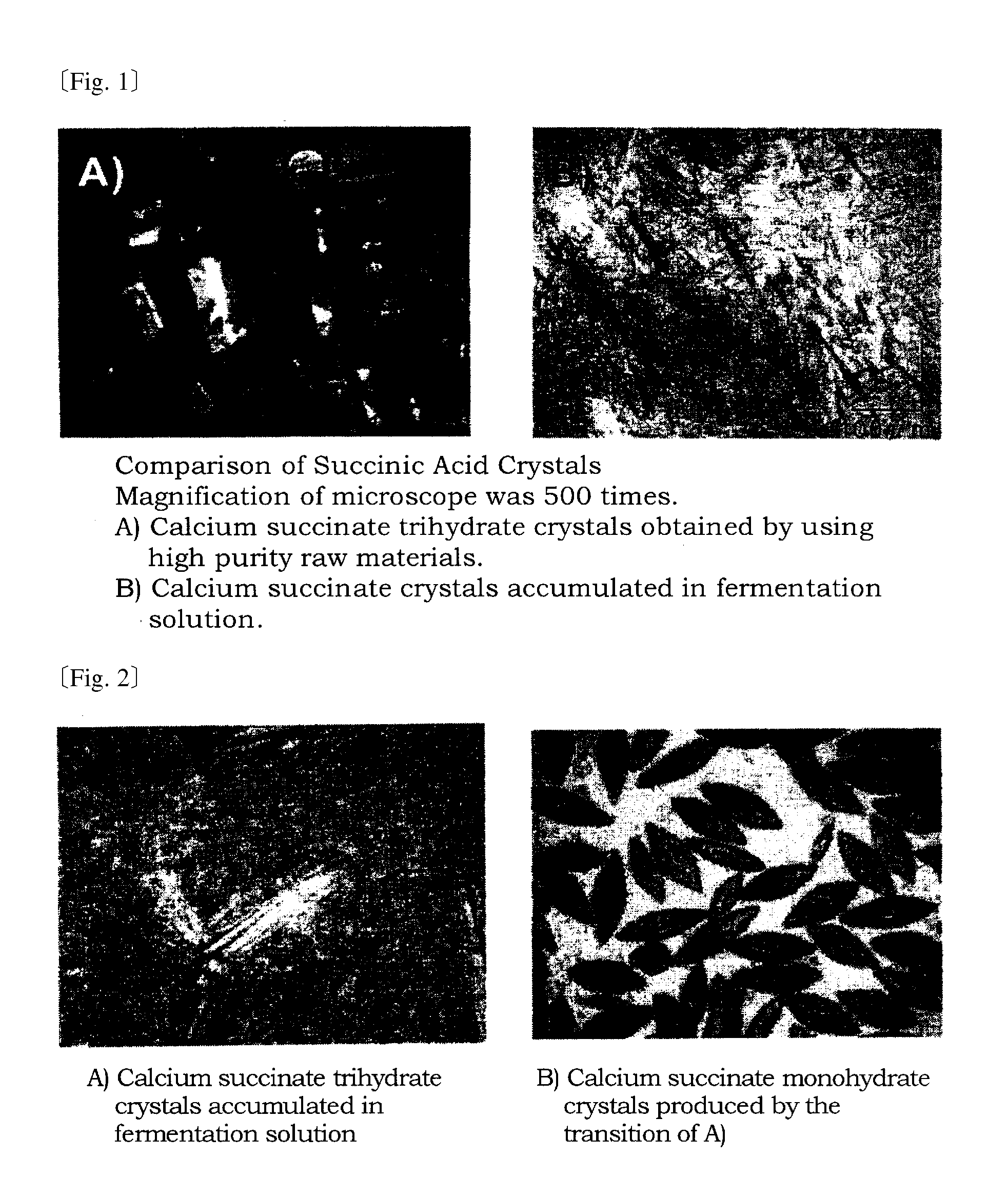Method of manufacturing succinic acid and ammonium succinate solutions
a technology of ammonium succinate and succinic acid, which is applied in the field of manufacturing succinic acid and ammonium succinate solutions, can solve the problems of inconvenient method, limited method to succinic acid salts with monovalent bases, and method limitations, and achieve the effect of hydrating the produced calcium oxide and facilitating production
- Summary
- Abstract
- Description
- Claims
- Application Information
AI Technical Summary
Benefits of technology
Problems solved by technology
Method used
Image
Examples
example 1
[0079]A method is described with the following steps: the crystallization fermentation step for manufacturing calcium succinate trihydrate using the strain Corynebacterium glutamicum MJ233 / Δldh and neutralizing with calcium hydroxide, the transition step for producing calcium succinate monohydrate by heating the culture solution, the crystal separation step for separating crystals from the reaction solution, the salt substitution step for substituting the calcium salt with the ammonium salt, and the solid-liquid separation step to obtain calcium carbonate that precipitates from the ammonium salt solution.
[0080]Step A: Fermentation Step
[0081]Seed Culture:
[0082]A 100 ml culture medium containing 30 g / l glucose, 0.4 g / l magnesium sulfate 7 hydrates, 1.0 g / l potassium dihydrogen phosphate, 12 g / l urea, 0.5 g / l DL-methionine, 10 mg / l ferrous sulfate 7 hydrates, 10 mg / l manganese sulfate 5 hydrates, 0.3 mg / l D-biotin, 0.2 mg / l thiamin hydrochloride, 28.6 ml / l soybean protein hydrolyzate (...
example 2
[0096]The influence of the quantity of ammonium carbonate in the salt substitution step was examined. To 80 g calcium succinate monohydrate (Junsei Kagaku Co., Ltd., guaranteed grade), 188 g water was added to form a slurry solution with a 20% by weight succinic acid concentration. To this solution, varying quantities of ammonium carbonate were added. After reacting for 2 hours with stirring, ammonium succinate solutions were obtained by centrifugation to remove precipitates.
[0097]The analyzed results of the obtained ammonium salt solutions are shown in Table 3. It indicates that 97.7% of calcium was removed from the solution by adding equimolar ammonium carbonate with the calcium in the slurry, and the succinic acid was recovered as an ammonium salt solution. It was found that almost 100% of the calcium was removed by adding a slight excess of ammonium carbonate, i.e, 1.5 times the quantity of the calcium, and succinic acid was completely converted to ammonium salt.
TABLE 3Experimen...
example 3
[0098]Using the calcium succinate monohydrate crystals obtained from the reaction solution similar to Example 1, experiments were carried out similar to Example 2 with varying quantities of ammonium carbonate. To 50 g of calcium succinate crystals (succinic acid:19.2 g), 153 g water was added, and suspended with stirring to form a 10 wt. % succinic acid slurry. Ammonium carbonate was added, and allowed to react at an ordinary temperature for 2 hours with stirring. After the reaction, precipitates were removed by centrifugation to obtain an ammonium succinate solution.
[0099]The results of the obtained ammonium salt solutions are shown in Table 4. They indicate that 92% or more of the calcium in the slurry can be removed as precipitates by adding ammonium carbonate in a quantity 0.5 time or more relative to the moles of the calcium in the slurry. It also indicates that 99% or more of the calcium in the slurry can be removed as precipitates by adding ammonium carbonate in a quantity 1....
PUM
| Property | Measurement | Unit |
|---|---|---|
| temperature | aaaaa | aaaaa |
| reaction time | aaaaa | aaaaa |
| time | aaaaa | aaaaa |
Abstract
Description
Claims
Application Information
 Login to View More
Login to View More - R&D
- Intellectual Property
- Life Sciences
- Materials
- Tech Scout
- Unparalleled Data Quality
- Higher Quality Content
- 60% Fewer Hallucinations
Browse by: Latest US Patents, China's latest patents, Technical Efficacy Thesaurus, Application Domain, Technology Topic, Popular Technical Reports.
© 2025 PatSnap. All rights reserved.Legal|Privacy policy|Modern Slavery Act Transparency Statement|Sitemap|About US| Contact US: help@patsnap.com

